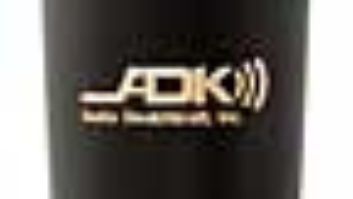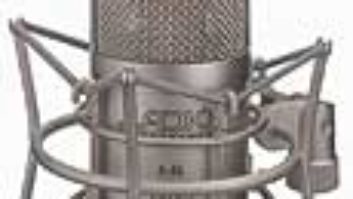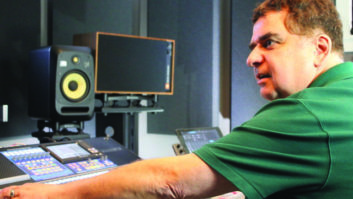ADK made waves a few years ago with the debut of its A-51 (Area 51) Series of affordable — around $400 — large-diaphragm FET condenser mics. Following on that success, ADK introduced a series of tube condensers, including the model A-51TC reviewed here, and the flagship Area 51TT.
The A-51TC sports a, um, “classic” appearance and is solid and well-built. Its aluminum casing measures 6.5 inches long and 2.1 inches in diameter, and the mic weighs 18.5 ounces. Inside, there’s a 1-inch diameter capsule with a cardioid polar pattern — the more expensive 51TT has dual 1-inch diaphragms and nine polar patterns, and a 6072 vacuum tube. Sensitivity is given as 14 mV/Pa2 -37 dBV (0 dBV), with a frequency response of 20 to 20k Hz and a max SPL of 125 dB (1% THD @ 1 kHz). Retailing at $999, the mic includes a power supply, shockmount and hard case.
I used the A-51TC in my project studio over a two-month period. I tested it using a variety of mic preamps, both tube and solid-state, but mostly I used the onboard mic pre’s in my Yamaha 03D digital mixer. The 03D’s mic pre’s are clean and were a good match for the A-51TC’s tube-driven character. By extrapolation, it is reasonable to assume that the mic would perform well in combination with most digital systems.
My first experience using the A-51TC was a poetry reading session. The previous night we had used another large-diaphragm tube mic — that costs twice as much as the ADK — with mixed results. The A-51TC had considerably more richness and character, handled the sibilants and plosives much more smoothly, and was easier for the (male) talent to “work” closely without bumping up against the proximity effect. It also sucked in the faint, unwanted background sounds with greater definition and clarity, but that wasn’t the microphone’s fault.
I also used the A-51TC to record acoustic guitar and Dobro. In both cases, I placed the mic slightly off-axis, about 18 inches away from the playing area of the instrument, and got a full sound, with the right touch of crispness in the top end. The lower frequencies on the Dobro were rendered particularly effectively, in balance with the highs, which is not the case with many mics, even large-diaphragm condensers.
The A-51TC handles a variety of percussion instruments. It captured both the low boom and the high “tok” sounds of a long-throated doumbek — while at the same time picking up the most subtle hand sounds — all in perfect balance. Placed just inside the bottom of a small conga, the ADK delivered a tight, punchy sound. When it was used to record a set of car keys on a ring (used as a percussion instrument), there was no excessive scratchiness. In short, the mic basically reproduced the full range of sounds present, without overly emphasizing any particular frequency. That’s not to say that there was no personality imparted to the sound, because in all cases there was a tiny bit of (tube) fuzziness at around 8 kHz — but it was a pleasant fuzziness.
Placed directly in front of a blaring guitar amp, the A-51TC easily held its own, enriching the sound with a throaty warmth, making the relatively small amp sound huge, particularly on heavily distorted settings. Finally, the A-51TC did an excellent job on a male blues vocalist, capturing the richness and gritty complexity in great detail. The vocalist loved the sound of the mic and asked if it could be used for a live performance.
Overall, the ADK A-51TC has a large and likable sound, and the coloration it does impart was a good match for a variety of sources, especially those with complex harmonics and overtones. If you are searching for a large-diaphragm tube condenser in the $1,000 range, then you should give the A-51TC an attentive listen.
ADK Microphones, 10816 N.W. 69th Ave., Ridgefield, WA 98642; 360/566-9400; fax 360/566-1282; www.adkmic.com.
The associate editor of Onstage magazine, Barry Cleveland also plays guitar in the improvisational quintet Cloud Chamber (www.innerviews.org/inner/cloud.html) and is the author of Creative Music Production: Joe Meek’s Bold Techniques (www.artistpro.com).
ADK A-51TC Spec Sheet
Type: Condenser Pressure Gradient
Vacuum Tube: 6072
Sensitivity: 14 mV/Pa2 -37 dBV
(0 dBV=1v/Pa)
Bandwidth: 20 to 20k Hz
Impedance: <250 ohms
Max SPL: 125 dB (1% THD @ 1 kHz)
EIN (DIN 45405 CCIR 468-2): 28 dB
EIN (IEC 268-4, A-weighted): 18 dBA
S/N ratio @ 1 Pa: 76 dB
Connector: 7-pin XLR
Body Size: 6.5×2.1 inches
Body Weight: 18.5 ounces



